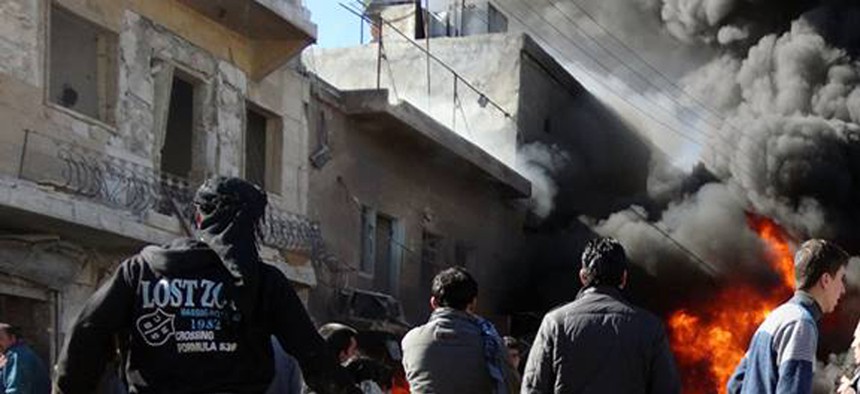
Syrian citizens gather near flames caused by a government forces warplane attack in al-Bab neighborhood of Aleppo, Syria, on Feb. 1, 2014. Aleppo Media Center/AP
The Specter of Chemical Warfare Returns to the Middle East
Assad's army dropped chlorine gas on a northern Syrian town, say activists, while Kurdish forces allege ISIS use of the same weapon against them near Mosul.
A Syrian opposition group claimed Tuesday that Bashar al-Assad's government carried out a chlorine-gas attack in the northern town of Sarmin, killing six people and injuring dozens more on Monday night. Government helicopters reportedly dropped barrel bombs full of the toxic chemical—if inhaled, the gas can burn the lungs, choking victims to death.
The alleged attack would be the latest in a series of reported uses of chemical weapons in the region, and it raises questions about the 2013 deal between Syria, Russia, and the United States to destroy the Syrian regime's chemical weapons stockpile.
What's the Evidence That There Was a Gas Attack?
Collecting the samples needed to verify the details of chemical-weapons attack is extremely difficult in a warzone. A UN investigation into reports that Syria had used chemical weapons in 2013 took weeks, and though it strongly implicated the Syrian regime, it did not definitively identify the government as the perpetrator. Nor did a U.S.-drafted UN Security Council resolution condemning those attacks. And the Syrian regime has already denied responsibility for Monday's reported chlorine attack, keeping with its pattern of blaming opposition forces.
There are also signs that the use of chemical weapons could be spreading in the region: Kurdish authorities alleged in recent days that ISIS had used chlorine gas as a weapon against their forces in northern Iraq in January; last October, Iraqi officials accused ISIS forces of staging a series of chlorine gas attacks in September. Al-Qaeda detonated chlorine bombs in Iraq in 2007.
What Laws Does Chemical Warfare Violate?
International agreements like the 1925 Geneva Protocol—crafted after the use of poison gas in World War I—have created a strong prohibition against the use of chemical or biological weapons, and the Obama administration took a tough stance following the deadly August 2013 sarin-gas attack in a Damascus suburb. “What message will we send if a dictator can gas hundreds of children to death in plain sight and pay no price?” he asked. (Obama had called chemical-weapons use a "red line" that would change the American calculus toward Syria's civil war.)
A U.S. strike on Syria was averted by a deal that called for "the complete elimination" of the country's chemical-weapons materials. In June 2014, international weapons inspectors announced that Syria had handed over all of its declared stockpile.
What Does This Say About International Mandates on Chemical Warfare?
If verified, the latest use of chemical bombs would expose a major gap in the weapons deal: Chlorine gas has various industrial and sanitary uses (e.g., pool cleaning) and isn't really considered a chemical weapon until it's used as one. Syria never included it on its list of declared chemical weapons, and Monday's alleged attack would confirm Kerry's fears that "our work is not finished." The AP gave an activist's description of Sarmin after the barrel bombs:
Asad Kanjo, an activist who is based in the nearby town of Saraqeb, said that after the first bomb was dropped, warnings broadcast over local mosque loudspeakers urged Sarmin residents to head for their roofs in order to avoid inhaling the gas, which settles in lower-lying areas.
"There was some kind of chaos," Kanjo said via Skype. He added that residents usually avoid going up to the roofs for fear of being targeted by government aircraft.




